Detroit, Michigan, Hgh State Clinic, Hgh Injections, Hrt Doctors
Detroit, Michigan Blood Testing Facilities
 Represents a LabCorp blood testing facility
Represents a LabCorp blood testing facility Represents a Quest Diagnostics blood testing facility
Represents a Quest Diagnostics blood testing facility
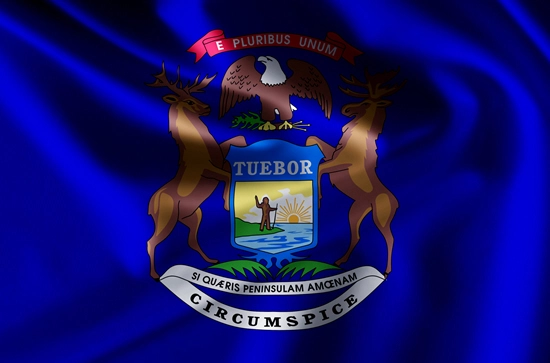
Nearby Labcorp Blood Testing facilities:
- Labcorp Center Distance: 8 m, 5250 Auto Club Dr Ste 310A, Dearborn, Wayne County, MI, 48126
- Labcorp Center Distance: 16 m, 20276 Middlebelt Ste 7, Livonia, Wayne County, MI, 48152
- Labcorp Center Distance: 20 m, 1701 South Boulevard E Ste 107, Rochester Hills, Oakland County, MI, 48307
- Labcorp Center Distance: 22 m, 2191 S Blvd, Auburn Hills, Oakland County, MI, 48326
- Labcorp Center Distance: 57 m, 1565 S Byrne Rd Ste 105, Toledo, Lucas County, OH, 43614
- Labcorp Center Distance: 76 m, 2269 Cooper Foster Park Rd F, Amherst, Lorain County, OH, 44001
- Labcorp Center Distance: 79 m, 272 Benedict Ave, Norwalk, Huron County, OH, 44857
- Labcorp Center Distance: 82 m, 418 E Broad St, Elyria, Lorain County, OH, 44035
- Labcorp Center Distance: 94 m, 6789 Ridge Rd Ste 210, Parma, Cuyahoga County, OH, 44129
- Labcorp Center Distance: 95 m, 5 Severance Circle Ste 210, Cleveland Heights, Cuyahoga County, OH, 44118
- Labcorp Center Distance: 96 m, 2110 16Th Street, Bay City, Bay County, MI, 48708
- Labcorp Center Distance: 97 m, 35040 Chardon Rd Ste G300, Willoughby, Lake County, OH, 44094
- Labcorp Center Distance: 98 m, 8300 Tyler Blvd Ste 205, Mentor, Lake County, OH, 44060
Nearby Quest Blood Testing facilities:
- Quest Center Distance: 10 m, 26400 Van Dyke Ave, Center Line, Macomb County, MI, 48015-1216
- Quest Center Distance: 12 m, 25070 Michigan Ave, Dearborn, Wayne County, MI, 48124-1740
- Quest Center Distance: 14 m, 14720 King Rd, Riverview, Wayne County, MI, 48193-7973
- Quest Center Distance: 15 m, 555 W 14 Mile Rd, Clawson, Oakland County, MI, 48017-3100
- Quest Center Distance: 16 m, 11583 Farmington Rd, Livonia, Wayne County, MI, 48150-5729
- Quest Center Distance: 17 m, 38815 Dequindre Rd, Troy, Oakland County, MI, 48083-5769
- Quest Center Distance: 19 m, 42500 Hayes Rd, Clinton Township, Macomb County, MI, 48038-6768
- Quest Center Distance: 20 m, 2050 N Haggerty Rd, Canton, Wayne County, MI, 48187-3796
- Quest Center Distance: 22 m, 135 Barclay Cir, Rochester Hills, Oakland County, MI, 48307-4599
- Quest Center Distance: 29 m, 6620 Highland Rd, Waterford, Oakland County, MI, 48327-1682
- Quest Center Distance: 31 m, 1424 S Lapeer Rd, Lake Orion, Oakland County, MI, 48360-1437
- Quest Center Distance: 32 m, 1046 N Monroe St, Monroe, Monroe County, MI, 48162-2936
- Quest Center Distance: 33 m, 5825 Ortonville Rd, Clarkston, Oakland County, MI, 48346-2983
- Quest Center Distance: 46 m, 234 W Caroline St, Fenton, Genesee County, MI, 48430-2807
- Quest Center Distance: 47 m, 425 N Fenway Dr, Fenton, Genesee County, MI, 48430-3810
- Quest Center Distance: 50 m, 944 Baldwin Rd, Lapeer, Lapeer County, MI, 48446-3089
- Quest Center Distance: 52 m, 6011 Porter Rd, Grand Blanc, Genesee County, MI, 48439-8538
- Quest Center Distance: 53 m, 3950 Sunforest Ct, Toledo, Lucas County, OH, 43623-4485
- Quest Center Distance: 56 m, 4067 East Court St, Burton, Genesee County, MI, 48509-2509
- Quest Center Distance: 59 m, 1397 S Linden Rd, Flint, Genesee County, MI, 48532-4194
- Quest Center Distance: 60 m, 5080 Villa Linde Pkwy, Flint, Genesee County, MI, 48532-3423
- Quest Center Distance: 63 m, 11515 N Saginaw St, Mount Morris, Genesee County, MI, 48458-2049
- Quest Center Distance: 65 m, 2500 West Strub Rd, Sandusky, Erie County, OH, 44870-5366
- Quest Center Distance: 69 m, 300 W Washington Ave, Jackson, Jackson County, MI, 49201-2180
- Quest Center Distance: 82 m, 6185 Dixie Hwy, Bridgeport, Saginaw County, MI, 48722-9618
- Quest Center Distance: 86 m, 20455 Lorain Rd, Fairview Park, Cuyahoga County, OH, 44126-3495
- Quest Center Distance: 90 m, 2062 N Center Rd, Saginaw, Saginaw County, MI, 48603-3716
- Quest Center Distance: 91 m, 4705 Towne Centre Rd, Saginaw, Saginaw County, MI, 48604-2818
- Quest Center Distance: 94 m, 7451 West Ridgewood Dr, Parma, Cuyahoga County, OH, 44129-5534
- Quest Center Distance: 97 m, 201 E. High St, Bryan, Williams County, OH, 43506-0000
Detroit Hormone Replacement Therapy Services
Are you concerned with maintaining your health and wellness as you grow older? Did you know that maintaining Hormone Balance is one of the keys to optimizing your longevity and preserving your overall quality of life? The Conscious Evolution Institute is one of the nation's top providers of quality HRT Products and Services, and we are proud to offer our Hormone Treatments to the entire Detroit metropolitan area.
We have streamlined the process of Hormone Deficiency Diagnosis and Treatment, allowing us to provide you with fantastic treatment options quickly and at a highly competitive cost. We work with Online Pharmacies which specialize in Bio-Identical and Recombinant Hormone Therapy, so our prices are second to none! Give us a call for a free consultation, or fill out the form located on this page to get started!
Detroit Human Growth Hormone Therapy for HGH Deficiency
One of the most asked about services that we provide at the Conscious Evolution Institute is HGH Injection Therapy. Growth Hormone Deficiency is a real and serious medical condition which is associated with a wide variety of health issues from diabetes to Alzheimer's Disease. Human Growth Hormone is incredibly important, because it optimizes cellular metabolism, meaning that it helps cells do their jobs faster and more efficiently. HGH Deficiency becomes more common the older that we get. Growth Hormone Levels facilitate peak wellness during the late teens and twenties, but the production of this important hormone goes into decline beyond the age of thirty.
This doesn't cause any problems at first, but eventually, the slow decline leads to major changes in health and wellness, including depression, cognitive decline, slower body fat metabolism, fatigue, loss of bone mineral density, sleep disruption, trouble healing, and increased risk of illness. If our diagnostic evaluation shows that you are indeed suffering from HGH Deficiency, we can provide you with quality HGH Injection Therapy designed to help you in your quest to feel and look better than you have in years.
Detroit Sermorelin for HGH Restoration
Bio-Identical Human Growth Hormone may be more than capable of increasing HGH Levels to ideal concentrations, but Sermorelin Therapy is a new treatment option which may be even better than Injectable HGH for many patients. Sermorelin is a Recombinant Hormone Therapy which mimics the activity of a hormone known as Growth Hormone-Releasing Hormone, or GH-RH. With Sermorelin, it is possible to optimize HGH Levels by stimulating the human pituitary to produce as much Human Growth Hormone as it needs to provide the most benefits to the adult patient. Sermorelin is cheaper than HGH and can be prescribed off-label, which makes it a fantastic alternative to Human Growth Hormone, providing the same benefits with an improved safety profile.
Detroit Testosterone Treatments for Andropause and Low-T
Are you a man, thirty years or older, that has experienced issues with fatigue, depression, and sexual inadequacy in recent months or years? If so, you may be suffering from Testosterone Deficiency, and our clinic can provide you with Testosterone Gels, Creams, Patches, or Injections to help get your Testosterone Levels back to their youthful peak. Testosterone is the hormone which examplifies masculinity, and as Testosterone Production declines, it leads to several interconnected health issues which affect the body, the mind, and the sexual ability of the patient. With Testosterone Replacement Therapy, it is possible to rejuvenate yourself, and enhance your ability to sieze the day.
Detroit HCG Injections for Weight Loss
HCG Therapy is a Physician-Monitored Hormone Treatment designed to help patients that are overweight or obese reach a healthy weight by facilitating body fat metabolism in combination with a low calorie diet. With the HCG Diet, patients have reported weight loss achievements of up to thirty pounds per month, without feeling hungry or tired. Bio-Identical HCG Injections maintain muscle mass while supercharging the body's ability to burn bodyfat. Call us to learn more about how HCG Works and whether the HCG Diet is right for you!
Detroit Information
Detroit, Michigan is the most populous city in the state of Michigan, and lies on the banks of the Detroit River and Lake St. Clair. Detroit is located immediately across the Canadian border from Windsor, Canada. Detroit goes by many nicknames, including Rock City, the Automotive Capital of the World, and the Motor City. Detroit is classically known for being the most important manufacturing hub of the Rust Belt, and is now in a period of transition as the automotive industry has largely moved out of the United States and the midwest. In spite of the changing landscape, Chrysler and General Motors still remain important employers in the city.
Today, the most important economic drivers of the city of Detroit are government, education, and healthcare, with top employers including Wayne State University, the Henry Ford Health System, and the Detroit Medical Center. Quicken Loans is the largest private employer in the state of Detroit.
In spite of the reputation that Detroit has gotten in recent years, the city still remains an incredibly robust and important American city. The population may have dropped significantly over the past half century, but the Detroit metropolitan area has maintained a steady population of over four million people. Downtown Detroit in particular has been experiencing a renaissance as of late, as jobs and entertainment quickly return to the city. Detroit is a major sports city, and is the home of many professional teams, including the Detroit Pistons, the Detroit Redwings, the Detroit Tigers, and the Detroit Lions.
Detroit made a name for itself in the mid-20th century as a major city for jazz, blues, and rock & roll, most notable for being the home of Motown Records. Many modern artists hail from Detroit, including Eminem, Kid Rock, and the White Stripes. There are many museums and landmarks that draw tourists to Detroit, including the Detroit Science Center, the Belle Isle Conservatory, and the Detroit Institute of Arts. Major festivals and events in Detroit include the North American International Auto Show, the International Jazz Festival, and the Electronic Music Festival.
All About Detroit, Michigan Geographic Area
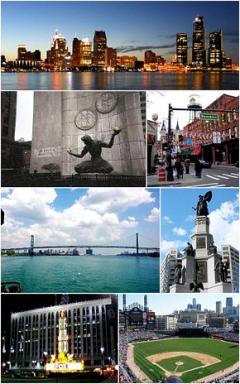
Detroit ( /diËntrÉeɪt/) is the largest city in the U.S. state of Michigan, and the seat of Wayne County. It is the major city among the primary cultural, financial, and transportation centers in the Metro Detroit area, a region of 5.2 million people, and serves as a major port on the Detroit River connecting the Great Lakes system to the Saint Lawrence Seaway. It was founded on July 24, 1701, by the French explorer, adventurer, and nobleman Antoine de la Mothe, sieur de Cadillac.
/diËntrÉeɪt/) is the largest city in the U.S. state of Michigan, and the seat of Wayne County. It is the major city among the primary cultural, financial, and transportation centers in the Metro Detroit area, a region of 5.2 million people, and serves as a major port on the Detroit River connecting the Great Lakes system to the Saint Lawrence Seaway. It was founded on July 24, 1701, by the French explorer, adventurer, and nobleman Antoine de la Mothe, sieur de Cadillac.
In 2010, the city had a population of 713,777 and ranked as the 18th most populous city in the United States. The name Detroit sometimes refers to the Metro Detroit area with a population of 4,296,250 for the six-county Metropolitan Statistical Area, the United States' 13th-largest, and a population of 5,218,852 for the nine-county Combined Statistical Area as of the 2010 Census. The Detroit aeWindsor area, a critical commercial link straddling the Canada aeU.S. border, has a total population of about 5,700,000.
Known as the world's traditional automotive center, "Detroit" is a metonym for the American automobile industry and an important source of popular music legacies celebrated by the city's two familiar nicknames, the Motor City and Motown. Other nicknames arose in the 20th century, including City of Champions beginning in the 1930s for its successes in individual and team sport, The D, D-Town, Hockeytown (a trademark owned by the city's NHL club, the Red Wings), Rock City (after the Kiss song "Detroit Rock City"), and The 313 (its telephone area code) Detroit became known as the "great arsenal of democracy" for its support of the U.S. role among the Allied powers during World War II.
Detroit and the surrounding region constitute a major center of commerce and global trade. The Detroit area emerged as a metropolitan region with construction of an extensive freeway system in the 1950s and 1960s which has expanded in ensuing decades. Freeways and transit systems have facilitated movement throughout the region with millions of people taking up residence in the suburbs. Between 2000 and 2010, the city's population fell by 25%, from the nation's 10th largest city to 18th. Commensurate with the shift of population and jobs to its suburbs, the city has had to adjust its role within the larger metropolitan area. Downtown Detroit has seen an increased role as an entertainment hub in the 21st century with the opening of three casino resort hotels, new stadiums, and a revitalized riverfront. The metropolitan region currently holds roughly one-half of the state's population.
The city's name originates from the Detroit River (French: le detroit du Lac Rorie, meaning the strait of Lake Erie), linking Lake Huron and Lake Erie; in the historical context, the strait included Lake St. Clair and the St. Clair River. Traveling up the Detroit River in 1679 on the ship Le Griffon with Cavelier de La Salle, Father Louis Hennepin noted the north bank of the river as an ideal location for a settlement.
There, in 1701, the French officer Antoine de La Mothe Cadillac, along with fifty-one additional French-Canadians, founded a settlement called Fort Ponchartrain du Detroit, naming it after the comte de Pontchartrain, Minister of Marine under Louis XIV. France offered free land in order to attract families to Detroit, which grew to 800 people in 1765, the largest city between Montreal and New Orleans.
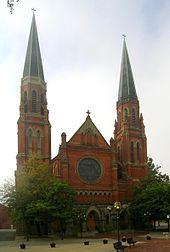
Francois Marie Picote, sieur de Belestre (Montreal 1719 ae1793) was the last French military commander at Fort Detroit (1758 ae1760), surrendering the fort on November 29, 1760 to the British. The region's fur trade was an important economic activity. Detroit's city flag reflects this French heritage. (See Flag of Detroit, Michigan).
During the French and Indian War (1760), British troops gained control and shortened the name to Detroit. Several tribes led by Chief Pontiac, an Ottawa leader, launched Pontiac's Rebellion (1763), including a siege of Fort Detroit. Partially in response to this, the British Royal Proclamation of 1763 included restrictions on white settlement in unceded Indian territories. Detroit passed to the United States under the Jay Treaty (1796). In 1805, fire destroyed most of the settlement. A river warehouse and brick chimneys of the wooden homes were the sole structures to survive.
From 1805 to 1847, Detroit was the capital of Michigan. As the city expanded, the street layout plan developed by Augustus B. Woodward, Chief Justice of the Michigan Territory was followed. Detroit fell to British troops during the War of 1812 in the Siege of Detroit, was recaptured by the United States in 1813 and incorporated as a city in 1815.
Prior to the American Civil War, the city's access to the Canadian border made it a key stop along the underground railroad. Then a Lieutenant, the future president Ulysses S. Grant was stationed in the city. His dwelling is still at the Michigan State Fairgrounds. Because of this local sentiment, many Detroiters volunteered to fight during the American Civil War, including the 24th Michigan Infantry Regiment (part of the legendary Iron Brigade) which fought with distinction and suffered 82% casualties at Gettysburg in 1863. At the arrival of the First Volunteer Infantry Regiment in Washington, Abraham Lincoln is quoted as saying "Thank God for Michigan!" Following the death of President Abraham Lincoln, George Armstrong Custer delivered a eulogy to the thousands gathered near Campus Martius Park. Custer led the Michigan Brigade during the American Civil War and called them the Wolverines.
During the late 19th and early 20th centuries, many of the city's Gilded Age mansions and buildings arose. Detroit was referred to as the Paris of the West for its architecture, and for Washington Boulevard, recently electrified by Thomas Edison. Strategically located along the Great Lakes waterway, Detroit emerged as a transportation hub. The city had grown steadily from the 1830s with the rise of shipping, shipbuilding, and manufacturing industries. In 1896, a thriving carriage trade prompted Henry Ford to build his first automobile in a rented workshop on Mack Avenue. During this period, Detroit expanded its borders annexing all or part of several surrounding villages and townships.
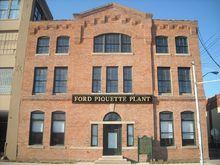
In 1903 Ford founded the Ford Motor Company. Ford's manufacturing aeand those of automotive pioneers William C. Durant, the Dodge brothers, Packard, and Walter Chrysler aereinforced Detroit's status as the world's automotive capital; it also served to encourage truck manufacturers such as Rapid and Grabowsky.
With the introduction of Prohibition, smugglers used the river as a major conduit for Canadian spirits, organized in large part by the notorious Purple Gang. Strained racial relations were evident in the 1920s trial of Dr. Ossian Sweet, a black Detroit physician acquitted of murder. A man died when shots were fired from Ossian's house into a threatening mob who gathered to try to force him out of a predominantly white neighborhood.
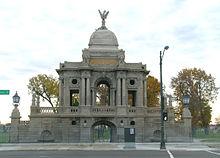
With the factories came high-profile labor unions in the 1930s such as the United Auto Workers which initiated disputes with manufacturers. The labor activism during those years increased influence of union leaders in the city such as Jimmy Hoffa of the Teamsters and Walter Reuther of the autoworkers. The 1940s saw the construction of the world's first urban freeway system below ground level, the Davison and the American automobile industry's productive capacity summoned to support the Allied powers during World War II which led to Detroit's nickname as the Arsenal of Democracy. There have been six ships of the United States Navy named after the city, including USS Detroit (LCS-7).
Industry spurred growth during the first half of the 20th century as the city drew tens of thousands of new residents, particularly workers from the Southern United States, to become the United States' fourth largest. At the same time, tens of thousands of European immigrants located in the city. Social tensions rose with the rapid pace of growth. The color blind promotion policies of the auto plants resulted in racial tension that erupted into a full-scale riot in 1943.
Consolidation during the 1950s, especially in the automobile sector, streamlined the supply chain. An extensive freeway system constructed in the 1950s and 1960s had facilitated commuting. In 1940, the city held about one-third of the state's population, while the metropolitan region currently holds roughly one-half. Commensurate with the shift of population and jobs to its suburbs, the city's tax base eroded.

During the African-American Civil Rights Movement of the 1950s and 1960s, Detroit witnessed social unrest, culminating in the Twelfth Street riot in July 1967. The gasoline crises of 1973 and 1979 impacted the U.S. auto industry as small cars from foreign makers made inroads.
Renaissance has been a common theme among city leaders, reinforced by the construction of the Renaissance Center in the late 1970s. This complex of skyscrapers, designed as a city within a city, together with other developments, slowed and eventually began to reverse the trend of businesses leaving Downtown Detroit by the late 1990s.
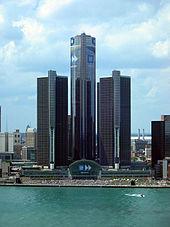
In 1980, Detroit hosted the Republican National Convention which nominated Ronald Reagan to a successful bid for President of the United States. During the 1980s, vacant structures were demolished to make way for new development and revitalization.
In the 1990s, the city began to receive a revival with much of it centered in the Downtown, Midtown, and New Center areas. One Detroit Center (1993) arose on the city skyline. In the ensuing years, three casinos opened: MGM Grand Detroit, Motor City Casino, and Greektown Casino which debuted as resort hotels in 2007 ae08. New downtown stadiums were constructed for the Detroit Tigers and Detroit Lions in 2000 and 2002, respectively; this put the Lions' home stadium in the city proper for the first time since 1974. The city also saw the historic Book Cadillac Hotel and the Fort Shelby Hotel reopen for the first time in over 20 years. The city hosted the 2005 MLB All-Star Game, 2006 Super Bowl XL, 2006 World Series, WrestleMania 23 in 2007, and the NCAA Final Four in April 2009 all of which prompted many improvements to the downtown area. In 2011, Detroit Medical Center and Henry Ford Health System substantially increased investments in medical research facilities and hospitals in the city's Midtown and New Center.
The city's riverfront is the focus of much development following the example of Windsor, Ontario which began its waterfront parkland conversion in the 1990s. In 2001, the first portion (stretching from Joe Louis Arena through Hart Plaza) of the International Riverfront was completed as a part of the city's 300th anniversary celebration. In succeeding years, the waterfront gained miles of parks and fountains. In 2011, the Port Authority Passenger Terminal opened with the river walk connecting Hart Plaza to the Renaissance Center. This development is a mainstay in the city's plan to enhance its economy through tourism. Along the river, developers are constructing upscale condominiums such as Watermark Detroit. Some city limit signs, particularly on the Dearborn border say "Welcome to Detroit, The Renaissance City Founded 1701."
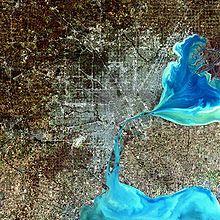
According to the United States Census Bureau, the city has a total area of 143.0 square miles (370 km2); of this, 138.8 square miles (359 km2) is land and 4.2 square miles (11 km2) is water. Detroit is the principal city in Metro Detroit and Southeast Michigan situated in the Midwestern United States and the Great Lakes region.
The highest elevation in the city is in the University District neighborhood in northwestern Detroit, west of Palmer Park, sitting at a height of 670 feet (200 m). Detroit's lowest elevation is along its riverfront, sitting at a height of 579 feet (176 m). On its northeast border are the communities of Grosse Pointe.
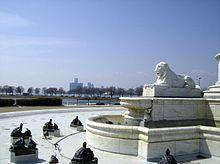
The Detroit River International Wildlife Refuge is the only international wildlife preserve in North America, uniquely located in the heart of a major metropolitan area. The Refuge includes islands, coastal wetlands, marshes, shoals, and waterfront lands along 48 miles (77 km) of the Detroit River and Western Lake Erie shoreline. Grosse Ile is the largest island in the Detroit River and the most populated island in Michigan. Belle Isle Park is a 982-acre (1.534 sq mi; 397 ha) island park in the Detroit River, between the Detroit and Windsor, Ontario. It is connected to the mainland by the MacArthur Bridge in Detroit. Belle Isle Park contains many sites of interest including the James Scott Memorial Fountain, the Anna Scripps Whitcomb Conservatory, the Detroit Yacht Club on an adjacent island, a half-mile (800 m) beach, a golf course, a nature center, monuments, and gardens. The city skyline may be viewed from the island.
Three road systems cross the city: the original French template, radial avenues from a Washington, D.C.-inspired system, and true north aesouth roads from the Northwest Ordinance township system. The city is north of Windsor, Ontario. Detroit is the only major city along the U.S. aeCanadian border in which one travels south in order to cross into Canada.
Detroit has four border crossings: the Ambassador Bridge and the Detroit aeWindsor Tunnel provide motor vehicle thoroughfares, with the Michigan Central Railway Tunnel providing railroad access to and from Canada. The fourth border crossing is the Detroit aeWindsor Truck Ferry, located near the Windsor Salt Mine and Zug Island. Near Zug Island, the southwest part of the city sits atop a 1,500-acre (610 ha) salt mine that is 1,100 feet (340 m) below the surface. The Detroit Salt Company mine has over 100 miles (160 km) of roads within.
Detroit and the rest of southeastern Michigan have a humid continental climate (Koppen Dfa) which is influenced by the Great Lakes. Winters are cold, with moderate snowfall and temperatures at night dropping below 0 °F ( na17.8 °C) around three times a year, while summers are warm to hot with temperatures exceeding 90 °F (32.2 °C) on 13.3 days. Snowfall, which typically peaks from December through February, averages 43.8 inches (111 cm) per season. Monthly averages range from 26.5 °F ( na3.1 °C) in January to 74.6 °F (23.7 °C) in July. The highest recorded temperature was 105 °F (40.6 °C) on July 24, 1934, while the lowest recorded temperature was na21 °F ( na29.4 °C) on January 19, 1994.

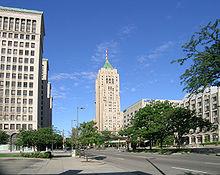

Seen in panorama, Detroit's waterfront shows a variety of architectural styles. The post modern neogothic spires of the One Detroit Center (1993) were designed to blend with the city aos Art Deco skyscrapers. Together with the Renaissance Center, they form a distinctive and recognizable skyline. Examples of the Art Deco style include the Guardian Building and Penobscot Building downtown, as well as the Fisher Building and Cadillac Place in the New Center area near Wayne State University. Among the city's prominent structures are United States' largest Fox Theatre, the Detroit Opera House, and the Detroit Institute of Arts.
While the downtown and New Center areas contain high-rise buildings, the majority of the surrounding city consists of low-rise structures and single-family homes. Outside of the city's core, residential high-rises are found in neighborhoods such as the East Riverfront extending toward Grosse Pointe and the Palmer Park neighborhood just west of Woodward. The University Commons-Palmer Park district in northwest Detroit is near the University of Detroit Mercy and Marygrove College which anchors historic neighborhoods including Palmer Woods, Sherwood Forest, and the University District.
The National Register of Historic Places lists several area neighborhoods and districts. Neighborhoods constructed prior to World War II feature the architecture of the times, with wood-frame and brick houses in the working-class neighborhoods, larger brick homes in middle-class neighborhoods, and ornate mansions in upper-class neighborhoods such as Brush Park, Woodbridge, Indian Village, Palmer Woods, Boston-Edison, and others.
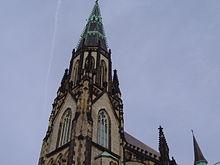
Some of the oldest neighborhoods are along the Woodward and East Jefferson corridors. Some newer residential construction may also be found along the Woodward corridor, the far west, and northeast. Some of the oldest extant neighborhoods include West Canfield and Brush Park which have both seen multi-million dollar restorations and construction of new homes and condominiums.
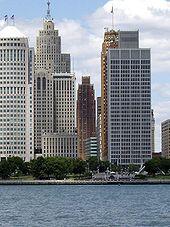
Many of the city's architecturally significant buildings are on the National Register of Historic Places and the city has one of United States' largest surviving collections of late 19th and early 20th century buildings. There are a number of architecturally significant churches and cathedrals throughout the city including St. Joseph's, Old St. Mary's, the Sweetest Heart of Mary, and the Cathedral of the Most Blessed Sacrament.
The city has substantial activity in urban design, historic preservation, and architecture. A number of downtown redevelopment projects aeof which Campus Martius Park is one of the most notable aehave revitalized parts of the city. Grand Circus Park stands near the city's theater district, Ford Field, home of the Detroit Lions, and Comerica Park, home of the Detroit Tigers. Other projects include the demolition of the Ford Auditorium off of Jefferson St.
The Detroit International Riverfront includes a partially completed three and one-half mile riverfront promenade with a combination of parks, residential buildings, and commercial areas from Hart Plaza to the MacArthur Bridge accessing Belle Isle (the largest island park in a U.S. city). The riverfront includes Tri-Centennial State Park and Harbor, Michigan's first urban state park. The second phase is a two mile (3 km) extension from Hart Plaza to the Ambassador Bridge for a total of five miles (8 km) of parkway from bridge to bridge. Civic planners envision that the riverfront properties condemned under eminent domain, with their pedestrian parks, will spur more residential development. Other major parks include Palmer (north of Highland Park), River Rouge (in the southwest side), and Chene Park (on the east river downtown).
Detroit has a variety of neighborhood types. The revitalized Downtown, Midtown, and New Center areas feature many historic buildings and are high density, while further out, particularly in the northeast and on the fringes, high vacancy levels are problematic, for which a number of solutions have been proposed. In 2007, Downtown Detroit was recognized as a best city neighborhood in which to retire among the United States' largest metro areas by CNN Money Magazine editors.

Lafayette Park is a revitalized neighborhood on the city's east side, part of the Ludwig Mies van der Rohe residential district. The 78-acre (32 ha) development was originally called the Gratiot Park. Planned by Mies van der Rohe, Ludwig Hilberseimer and Alfred Caldwell it includes a landscaped, 19-acre (7.7 ha) park with no through traffic, in which these and other low-rise apartment buildings are situated. Immigrants have contributed to the city's neighborhood revitalization, especially in southwest Detroit. Southwest Detroit has experienced a thriving economy in recent years, as evidenced by new housing, increased business openings and the recently opened Mexicantown International Welcome Center.
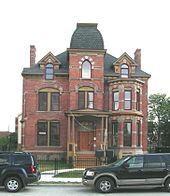
The city has numerous neighborhoods consisting of vacant properties resulting in low inhabited density in those areas, stretching city services and infrastructure. These neighborhoods are concentrated in the northeast and on the city's fringes. A 2009 parcel survey found about one fourth of residential lots in the city to be undeveloped or vacant, and about 10% of the city's housing to be unoccupied. The survey also reported that most (86%) of the city's homes are in good condition with a minority (9%) in fair condition needing only minor repairs. To deal with vacancy issues, the city has begun demolishing the derelict houses, razing 3,000 of the total 10,000 in 2010, but the resulting low density creates a strain on the city's infrastructure. To remedy this, a number of solutions have been proposed including resident relocation from more sparsely populated neighborhoods and converting unused space to agricultural use, though the city expects to be in the planning stages for up to another two years.
The number of stray dogs in the city's derelict areas has been estimated at 20,000. Fifty-nine Detroit postal workers were attacked by stray dogs in 2010, according to a Detroit postmaster.
Public funding and private investment have also been made with promises to rehabilitate neighborhoods. In April 2008, the city announced a $300-million stimulus plan to create jobs and revitalize neighborhoods, financed by city bonds and paid for by earmarking about 15% of the wagering tax. The city's working plans for neighborhood revitalizations include 7-Mile/Livernois, Brightmoor, East English Village, Grand River/Greenfield, North-End, and Osborn. Private organizations have pledged substantial funding to the efforts. Additionally, the city has cleared a 1,200-acre (490 ha) section of land for large-scale neighborhood construction, which the city is calling the Far Eastside Plan. In 2011, Mayor Bing announced a plan to categorize neighborhoods by their needs and prioritize the most needed services for those neighborhoods.
Downtown Detroit's population of young professionals is growing and retail is expanding. A number of luxury high rises have been built. The east river development plans include more luxury condominium developments. This dynamic is luring many younger residents to the city's Downtown along with the revitalized Midtown and New Center areas. A 2007 study found that Detroit's new downtown residents are predominantly young professionals (57 percent are ages 25 ae34, 45 percent have bachelor's degrees, 34 percent have a master's or professional degree). A desire to be closer to the urban scene has also attracted some young professionals to take up residence among the mansions of Grosse Pointe just outside the city. Detroit's proximity to Windsor, Ontario, provides for views and nightlife, along with Ontario's minimum drinking age of 19. A 2011 study by Walk Score recognized Detroit for its above average walkability among large U.S. cities. About two-thirds of suburban residents occasionally dine and attend cultural events or take in professional games in the city of Detroit.
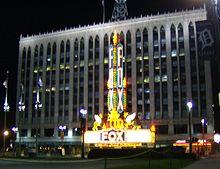
Live music has been a prominent feature of Detroit's nightlife since the late 1940s, bringing the city recognition under the nickname 'Motown'. The metropolitan area has many nationally prominent live music venues. Concerts hosted by Live Nation perform throughout the Detroit area. Large concerts are held at DTE Energy Music Theatre and The Palace of Auburn Hills. The Detroit Theatre District is the United States' second largest and hosts Broadway performances. Major theaters include the Fox Theatre, Music Hall, the Gem Theatre, Masonic Temple Theatre, the Detroit Opera House, the Fisher Theatre, The Fillmore Detroit, St. Andrews Hall, the Majestic Theatre, and Orchestra Hall which hosts the renowned Detroit Symphony Orchestra. The Nederlander Organization, the largest controller of Broadway productions in New York City, originated with the purchase of the Detroit Opera House in 1922 by the Nederlander family.
Motown Motion Picture Studios with 535,000 square feet (49,700 m2) produces movies in Detroit and the surrounding area based at the Pontiac Centerpoint Business Campus for a film industry expected to employ over 4,000 people in the metro area.
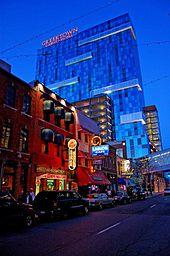
The city of Detroit has a rich musical heritage and has contributed to a number of different genres over the decades leading into the new millennium. Important music events in the city include: the Detroit International Jazz Festival, the Detroit Electronic Music Festival, the Motor City Music Conference (MC2), the Urban Organic Music Conference, the Concert of Colors, and the hip-hop Summer Jamz festival.
In the 1940s, Detroit blues artist John Lee Hooker became a long-term resident in the city's southwest Delray neighborhood. Hooker, among other important blues musicians migrated from his home in Mississippi bringing the Delta Blues to northern cities like Detroit. Hooker recorded for Fortune Records, the biggest pre-Motown blues/soul label. During the 1950s, the city became a center for jazz, with stars performing in the Black Bottom neighborhood. Prominent emerging Jazz musicians of the 1960s included: trumpet player Donald Byrd who attended Cass Tech and performed with Art Blakey and the Jazz Messengers early in his career and Saxophonist Pepper Adams who enjoyed a solo career and accompanied Byrd on several albums. The Graystone International Jazz Museum documents jazz in Detroit.
Other, prominent Motor City R&B stars in the 1950s and early 1960s was Nolan Strong, Andre Williams and Nathaniel Mayer ae who all scored local and national hits on the Fortune Records label. According to Smokey Robinson, Strong was a primary influence on his voice as a teenager. The Fortune label was a family-operated label located on Third Avenue in Detroit, and was owned by the husband and wife team of Jack Brown and Devora Brown. Fortune, which also released country, gospel and rockabilly LPs and 45s, laid the groundwork for Motown, which became Detroit's most legendary record label.
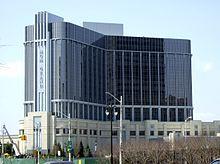
Berry Gordy, Jr. founded Motown Records which rose to prominence during the 1960s and early 1970s with acts such as Stevie Wonder, The Temptations, The Four Tops, Smokey Robinson & The Miracles, Diana Ross & The Supremes, the Jackson 5, Martha and the Vandellas, The Spinners, Gladys Knight & the Pips, and Marvin Gaye. Artists were backed by the Funk Brothers, the Motown house band that was featured in Paul Justman's 2002 documentary film Standing in the Shadows of Motown, based on Allan Slutsky's book of the same name. The Motown Sound played an important role in the crossover appeal with popular music, since it was the first African American owned record label to primarily feature African-American artists. Gordy moved Motown to Los Angeles in 1972 to pursue film production, but the company has since returned to Detroit. Aretha Franklin, another Detroit R&B star, carried the Motown Sound; however, she did not record with Berry's Motown Label.
Local artists and bands rose to prominence in the 1960s and 70s including: the MC5, The Stooges, Bob Seger, Amboy Dukes featuring Ted Nugent, Mitch Ryder and The Detroit Wheels, Rare Earth, Alice Cooper, and Suzi Quatro. The group Kiss emphasized the city's connection with rock in the song Detroit Rock City and the movie produced in 1999. In the 1980s, Detroit was an important center of the hardcore punk rock underground with many nationally known bands coming out of the city and its suburbs, such as The Necros, The Meatmen, and Negative Approach.
In 1990s and the new millennium, the city has produced a number of influential hip hop artists, including Eminem, the hip-hop artist with the highest cumulative sales, hip-hop producer J Dilla, rapper and producer Esham and hip hop duo Insane Clown Posse. Detroit is cited as the birthplace of techno music. Prominent Detroit techno artists include Juan Atkins, Derrick May, and Kevin Saunderson. The band Sponge toured and produced music, with artists such as Kid Rock and Uncle Kracker. The city also has an active garage rock genre that has generated national attention with acts such as: The White Stripes, The Von Bondies, The Dirtbombs, Electric Six, and The Hard Lessons.

Many of the area's prominent museums are located in the historic cultural center neighborhood around Wayne State University and the College for Creative Studies. These museums include the Detroit Institute of Arts, the Detroit Historical Museum, Charles H. Wright Museum of African American History, the Detroit Science Center, as well as the main branch of the Detroit Public Library. Other cultural highlights include Motown Historical Museum, the Pewabic Pottery studio and school, the Tuskegee Airmen Museum, Fort Wayne, the Dossin Great Lakes Museum, the Museum of Contemporary Art Detroit (MOCAD), the Contemporary Art Institute of Detroit (CAID), and the Belle Isle Conservatory. In 2010, the G.R. N'Namdi Gallery opened in a 16,000-square-foot (1,500 m2) complex in Midtown. Important history of America and the Detroit area are exhibited at The Henry Ford, the United States' largest indoor-outdoor museum complex. The Detroit Historical Society provides information about tours of area churches, skyscrapers, and mansions. Inside Detroit, meanwhile, hosts tours, educational programming, and a downtown welcome center. Other sites of interest are the Detroit Zoo in Royal Oak, the Cranbrook Art Museum in Bloomfield Hills, the Anna Scripps Whitcomb Conservatory on Belle Isle, and Walter P. Chrysler Museum in Auburn Hills.
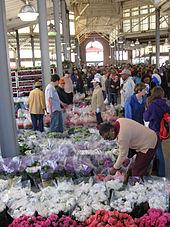
The city's Greektown and three downtown casino resort hotels serve as part of an entertainment hub. The Eastern Market farmer's distribution center is the largest open-air flowerbed market in the United States and has more than 150 foods and specialty businesses. On Saturdays, about 45,000 people shop the city's historic Eastern Market. The Midtown and the New Center area are centered on Wayne State University and Henry Ford Hospital. Midtown has about 50,000 residents and attracts millions of visitors each year to its museums and cultural centers; for example, the Detroit Festival of the Arts in Midtown draws about 350,000 people.
Annual summer events include the Electronic Music Festival, International Jazz Festival, the Woodward Dream Cruise, the African World Festival, the country music Hoedown, Noel Night, and Dally in the Alley. Within downtown, Campus Martius Park hosts large events, including the annual Motown Winter Blast. As the world's traditional automotive center, the city hosts the North American International Auto Show. Held since 1924, America's Thanksgiving Parade is one of the nation's largest. River Days, a five-day summer festival on the International Riverfront lead up to the Windsor-Detroit International Freedom Festival fireworks, which draw super sized-crowds ranging from hundreds of thousands to over three million people.
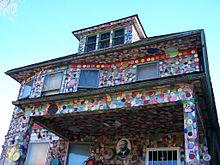
An important civic sculpture in Detroit is "Spirit of Detroit" by Marshall Fredericks at the Coleman Young Municipal Center. The image is often used as a symbol of Detroit and the statue itself is occasionally dressed in sports jerseys to celebrate when a Detroit team is doing well. A memorial to Joe Louis at the intersection of Jefferson and Woodward Avenues was dedicated on October 16, 1986. The sculpture, commissioned by Sports Illustrated and executed by Robert Graham, is a 24-foot (7.3 m) long arm with a fisted hand suspended by a pyramidal framework.
Artist Tyree Guyton created the controversial street art exhibit known as the Heidelberg Project in 1986, using found objects including cars, clothing and shoes found in the neighborhood near and on Heidelberg Street on the near East Side of Detroit. Guyton continues to work with neighborhood residents and tourists in constantly evolving the neighborhood-wide art installation.
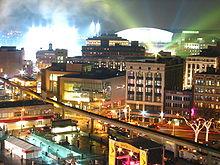
Detroit is one of 12 American metropolitan areas that are home to professional teams representing the four major sports in North America. All these teams but one play within the city of Detroit itself (the NBA's Detroit Pistons play in suburban Auburn Hills at The Palace of Auburn Hills). There are three active major sports venues within the city: Comerica Park (home of the Major League Baseball team Detroit Tigers), Ford Field (home of the NFL's Detroit Lions), and Joe Louis Arena (home of the NHL's Detroit Red Wings). A 1996 marketing campaign promoted the nickname "Hockeytown".
In college sports, Detroit's central location within the Mid-American Conference has made it a frequent site for the league's championship events. While the MAC Basketball Tournament moved permanently to Cleveland starting in 2000, the MAC Football Championship Game has been played at Ford Field in Detroit since 2004, and annually attracts 25,000 to 30,000 fans. The University of Detroit Mercy has a NCAA Division I program, and Wayne State University has both NCAA Division I and II programs. The NCAA football Little Caesars Pizza Bowl is held at Ford Field each December.
In 2012, a group of residents of Detroit founded a soccer team called the Detroit City Football Club. The team was created to promote the community. The team plays in the Midwestern Division of the National Premier Soccer League, and its nickname is Le Rouge.
Sailboat racing is a major sport in the Detroit area. Lake Saint Clair is home to many yacht clubs which host regattas. Bayview Yacht Club, the Detroit Yacht Club, Crescent Sail Yacht Club, Grosse Pointe Yacht Club, The Windsor Yacht Club, and the Edison Boat Club each participate in and are governed by the Detroit Regional Yacht-Racing Association or DRYA. Detroit is home to many One-Design fleets including, but not limited to, North American 40s, Cal 25s, Cuthbertson and Cassian 35s, Crescent Sailboats, Express 27s, J 120s, J 105, Flying Scots, and many more.
The Crescent Sailboat, NA-40, and the L boat were designed and built exclusively in Detroit. Detroit also has a very active and competitive junior sailing program.
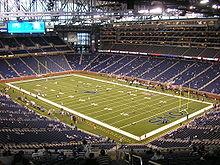
Since 1916, the city has been home to Unlimited Hydroplane racing, held annually (with exceptions) on the Detroit River near Belle Isle. Often, the hydroplane boat race is for the APBA Challenge Cup, more commonly known as the Gold Cup (first awarded in 1904, created by Tiffany) which is the oldest active motorsport trophy in the world.
The city hosted the Detroit Indy Grand Prix on Belle Isle Park from 1989 to 2001, 2007 to 2008, and 2012 and beyond. The event generated about $53 million in economic impact for the area. In 2007, open-wheel racing returned to Belle Isle with both Indy Racing League and American Le Mans Series Racing.
In the years following the mid-1930s, Detroit was referred to as the "City of Champions" after the Tigers, Lions, and Red Wings captured all three major professional sports championships in a seven-month period of time (the Tigers won the World Series in October, 1935; the Lions won the NFL championship in December, 1935; the Red Wings won the Stanley Cup in April, 1936). Gar Wood (a native Detroiter) won the Harmsworth Trophy for unlimited powerboat racing on the Detroit River in 1931. In the next year, 1932, Eddie "The Midnight Express" Tolan, a black student from Detroit's Cass Technical High School, won the 100- and 200-meter races and two gold medals at the 1932 Summer Olympics. Joe Louis won the heavyweight championship of the world in 1937. Also, in 1935 the Detroit Lions won the NFL championship. The Detroit Tigers have won ten American League pennants (The most recent being in 2006) and four World Series titles. In 1984, the Detroit Tigers' World Series championship, after which crowds had left three dead and millions of dollars in property damage. The Detroit Red Wings have won 11 Stanley Cups (the most by an American NHL Franchise), the Detroit Pistons have won three NBA titles, and the Detroit Shock have won three WNBA titles.
Detroit has the distinction of being the city which has made the most bids to host the Summer Olympics without ever being awarded the games: seven unsuccessful bids for the 1944, 1952, 1956, 1960, 1964, 1968 and 1972 games. It came as high as second place in the balloting two times, losing the 1964 games to Tokyo and the 1968 games to Mexico City.
Detroit hosts many WWE events such as the 2007 WWE's WrestleMania 23 which attracted 80,103 fans to Ford Field; the event marking the 20th anniversary of WrestleMania III which drew a reported 93,173 to the Pontiac Silverdome in nearby Pontiac in 1987. The city hosted the Red Bull Air Race in 2008 on the International Riverfront.
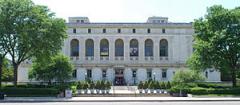
The Detroit Free Press and The Detroit News are the major daily newspapers, both broadsheet publications published together under a joint operating agreement. Media philanthropy includes the Detroit Free Press high school journalism program and the Old Newsboys' Goodfellow Fund of Detroit. In December, 2008, the Detroit Media Partnership announced that the two papers would reduce home delivery to three days a week, print reduced newsstand issues of the papers on non-delivery days and focus resources on Internet-based news delivery. These changes went into effect in March, 2009. Founded in 1980, the Metro Times is a weekly publication, covering news, arts & entertainment. Also founded in 1935 and based in Detroit the Michigan Chronicle is one of the oldest and most respected African-American weekly newspapers in America. Covering politics, entertainment, sports and community events. The Detroit television market is the 11th largest in the United States; according to estimates that do not include audiences located in large areas of Ontario, Canada (Windsor and its surrounding area on broadcast and cable TV, as well as several other cable markets in Ontario, such as the city of Ottawa) which receive and watch Detroit television stations.
Detroit has the 11th largest radio market in the United States, though this ranking does not take into account Canadian audiences.
Hardcore Pawn, an American documentary reality television series produced for truTV features the day-to-day operations of American Jewelry and Loan, a family-owned pawn shop on Greenfield Road.
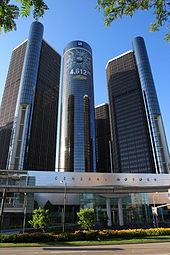
Detroit and the surrounding region constitute a major center of commerce and global trade, most notably as home to America's 'Big Three' automobile companies, General Motors, Ford, and Chrysler. About 80,500 people work in downtown Detroit, comprising one-fifth of the city's employment base. Detroit's six county Metropolitan Statistical Area has a population of about 4.3 million and a workforce of about 2.1 million. In May 2012, the Department of Labor reported metropolitan Detroit's unemployment rate at 9.9%, with the city's unemployment rate for April 2012 at 15.8%. The Detroit MSA had a gross metropolitan product of $197.7 billion in 2010.
In 2010, Quicken Loans relocated its world headquarters and 4,000 employees to downtown Detroit consolidating its suburban offices, a move considered of high importance to city planners to reestablish the historic downtown. Some Fortune 500 companies headquartered in Detroit include General Motors, auto parts maker American Axle & Manufacturing, and DTE Energy.[100] Other major industries include advertising, law, finance, biomedical research, health care, and computer software. The law firm of Miller, Canfield, Paddock & Stone, one of the largest in the U.S., has offices in both Detroit and Windsor. Wayne State University and medical service providers are major employers in the city. Metro Detroit area is one of the leading health care economies in the U.S. according to a 2003 study measuring health care industry components, with the region's hospital sector ranked fourth in the nation.[101]
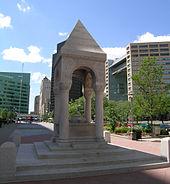
Casino gaming plays an important economic role, with Detroit the largest city in the United States to offer casino resort hotels.[102] Caesars Windsor, Canada's largest, complements the MGM Grand Detroit, MotorCity Casino, and Greektown Casino in Detroit. The casino hotels contribute significant tax revenue along with thousands of jobs for residents. Gaming revenues have grown steadily, with Detroit ranked as the fifth largest gambling market in the United States for 2007. When Casino Windsor is included, Detroit's gambling market ranks third or fourth. In an effort to support spending within the city, certain business owners set up "mints" to distribute the Detroit Community Scrip. The scrip is used at local clubs and bars to ensure some dollars stay within the city by establishing a note that is only legal tender at certain places.
There are about four thousand factories in the area.[103] The domestic auto industry is primarily headquartered in Metro Detroit. New vehicle production, sales, and jobs related to automobile use account for one of every ten jobs in the United States.[104] The area is also an important source of engineering job opportunities.[105] A 2004 Border Transportation Partnership study showed that 150,000 jobs in the Windsor-Detroit region and $13 billion in annual production depend on the City of Detroit's international border crossing.[106]
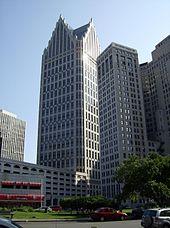
A rise in automated manufacturing using robotic technology has created related industries in the area; inexpensive labor in other parts of the world and increased competition have led to a steady transformation of certain types of manufacturing jobs in the region with the Detroit area gaining new lithium ion battery plants.[107][108][109] In addition to property taxes, residents pay an income tax rate of 2.50%.[110]
The city has cleared sections of land while retaining a number of historically significant vacant buildings in order to spur redevelopment;[111] though the city has struggled with finances, it issued bonds in 2008 to provide funding for ongoing work to demolish blighted properties. In 2006, downtown Detroit reported $1.3 billion in restorations and new developments which increased the number of construction jobs in the city. In decade leading up to 2006, downtown Detroit gained more than $15 billion in new investment from private and public sectors.[112]
The Detroit automakers and local manufacturing have made significant restructurings in response to market competition. GM began the initial public offering of stock in 2010.[113] General Motors has invested heavily in all fuel cell equipped vehicles,[114] while Chrysler has focused research and development into biodiesel. In August 2009, Michigan and Detroit's auto industry received $1.36 B in grants from the U.S. Department of Energy for the manufacture of lithium-ion batteries.[115] For 2010, the domestic automakers reported significant profits indicating the beginning of rebound along with an economic recovery for the Detroit area.[116] [117][118][119][120]
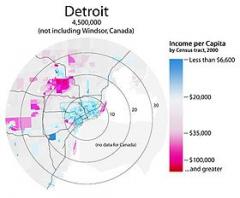
In 2010, the city had 713,777 residents. The name Detroit sometimes refers to Metro Detroit, a six-county area with a population of 4,296,250 for the Metropolitan Statistical Area, making it the United States' twelfth-largest, and a population of 5,218,852 for the nine-county Combined Statistical Area as of the 2010 Census Bureau estimates. The Detroit-Windsor area, a critical commercial link straddling the Canada-U.S. border, has a total population of about 5,700,000. Immigration continues to play a role in the region's projected growth.[121] Oakland County in Metro Detroit is among the more affluent counties in the U.S. with more than one million people.[122][123] [124]
Poverty has been a continued problem in the city proper.[125] For the 2010 American Community Survey, median household income in the city was $25,787, and the median income for a family was $31,011. The per capita income for the city was $14,118. 32.3% of families had income at or below the federally defined poverty level. Out of the total population, 53.6% of those under the age of 18 and 19.8% of those 65 and older had income at or below the federally defined poverty line.
The city's population increased more than sixfold during the first half of the 20th century, fed largely by an influx of European, Middle Eastern (Lebanese), (Assyrian/Chaldean), and Southern migrants to work in the burgeoning automobile industry.[129] In 1940, non-Hispanic whites were 90.4% of the city's population.[130] However, since 1950 the city has seen a major shift in its population to the suburbs. In 1910, fewer than 6,000 blacks called the city home;[131] in 1930 more than 120,000 blacks lived in Detroit.[132] The thousands of African Americans who came to Detroit were part of the Great Migration of the 20th century.[133]
At its peak in 1950, the city was the fifth-largest in the United States, but has since seen a major shift in its population to the suburbs. The city population has dropped from 1,849,568 in 1950 to 713,777 in 2010.[134] In the first decade of the 21st century, about two-thirds of the total black population in metropolitan area resided within the city limits of Detroit.[135]
As of the 2010 Census, there were 713,777 people, 269,445 households, and 162,924 families residing in the city. The population density was 5,144.3 people per square mile (1,986.2/km ²). There were 349,170 housing units at an average density of 2,516.5 units per square mile (971.6/km ²). The census reported that the city had 82.7% African American, 10.6% White (7.8% non-Hispanic white), 1.1% Asian, 0.4% Native American, 0.02% Pacific Islander, 3.0% other races, 2.2% two or more races. In addition, 6.8% of the population self-identified as Hispanic or Latino, of any race, mainly made up of Mexicans and Puerto Ricans.[136] Additionally, Detroit has one of the U.S.'s largest concentrations of Hmong people.[137] After World War II many people from Appalachia settled in Detroit. Because the Detroit community negatively perceived the Appalachians, they formed communities and their children gained southern accents.[138]
There were 269,445 households out of which 34.4% have children under the age of 18 living with them, 21.5% were married couples living together, 31.4% had a female householder with no husband present, and 39.5% were non-families, 34.0% of all households were made up of individuals and 3.9% had someone living alone who is 65 years of age or older. The average household size was 2.59 and the average family size was 3.36.
There is a wide age distribution in the city, with 31.1% under the age of 18, 9.7% from 18 to 24, 29.5% from 25 to 44, 19.3% from 45 to 64, and 10.4% who are 65 years of age or older. The median age was 31 years. For every 100 females there were 89.1 males. For every 100 females age 18 and over, there were 83.5 males.
Detroit remains one of the most racially segregated cities in the United States.[139][140] Blacks moved to the city en masse to escape Jim Crow in the south and find jobs.[141] However, they soon found themselves excluded from white areas of the city--through violence, laws, and economic discrimination (e.g., redlining).[142] White residents attacked black homes: breaking windows, starting fires, and exploding bombs.[142][139] This pattern was later magnified by white migration to the suburbs.[140]
A traditional boundary between black and white is Eight Mile Road, which separates the city from whiter suburbs to the north.[143]
One of the implications of racial segregation, which correlates with class segregation, may be overall worse health for some populations.[140][144]
According to the 2010 Census, segregation in Detroit has decreased in absolute and in relative terms. The number of integrated neighborhoods has increased from 100 in 2000 to 204 in 2010. The city has also moved down the ranking, from number one most segregated to number four.[145]
A 2011 op-ed in the New York Times attributed the decreased segregation rating to the overall exodus from the city, cautioning that these areas may soon become more segregated. This pattern already happened in the 1970s, when apparent integration was actually a precursor to white flight and resegregation.[139]
De facto educational segregation in Detroit (and by extension elsewhere) was legally permitted by the U.S. Supreme Court in Milliken v. Bradley, 418 U.S. 717 (1974).[146]
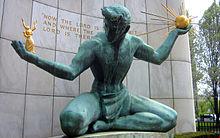
The city government is run by a mayor and nine-member city council and clerk elected on an at-large nonpartisan ballot. Since voters approved the city's charter in 1974, Detroit has had a "strong mayoral" system, with the mayor approving departmental appointments. The council approves budgets but the mayor is not obligated to adhere to any earmarking. City ordinances and substantially large contracts must be approved by the council. The city clerk supervises elections and is formally charged with the maintenance of municipal records. Municipal elections for mayor, city council and city clerk are held at four-year intervals, in the year after presidential elections.[147] Following a November 2009 referendum, seven council members will be elected from districts beginning in 2013 while two will continue to be elected at-large.[148]
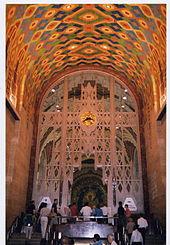
Detroit's courts are state-administered and elections are nonpartisan. The Probate Court for Wayne County is located in the Coleman A. Young Municipal Center in downtown Detroit. The Circuit Court is located across Gratiot Ave. in the Frank Murphy Hall of Justice, in downtown Detroit. The city is home to the Thirty-Sixth District Court, as well as the First District of the Michigan Court of Appeals and the United States District Court for the Eastern District of Michigan. The city provides law enforcement through the Detroit Police Department and emergency services through the Detroit Fire Department.
Detroit has several sister cities, including Chongqing (People's Republic of China), Dubai (United Arab Emirates), Kitwe (Zambia), Minsk (Belarus), Nassau, Bahamas, Toyota (Japan), and Turin (Italy).[149]
Politically, the city consistently supports the Democratic Party in state and national elections (local elections are nonpartisan). According to a study released by the Bay Area Center for Voting Research, Detroit is the most liberal large city in America,[150] measuring only the percentage of city residents who voted for the Democratic Party.[151]
In 2000, the City requested an investigation by the United States Justice Department into the Detroit Police Department which was concluded in 2003 over allegations regarding its use of force and civil rights violations. The city proceeded with a major reorganization of the Detroit Police Department.[152]
Planning and development have been important issues. In 1973, the city elected its first black mayor, Coleman Young. Despite development efforts, his combative style during his five terms in office was not well received by many suburban residents.[153] Mayor Dennis Archer, a former Michigan Supreme Court Justice, refocused the city's attention on redevelopment with a plan to permit three casinos downtown. By 2008, three major casino resort hotels established operations in the city.
The city has seen a significant reduction in crime since the 1970s. The city had the sixth highest rate of violent crime among the 25 largest U.S. cities in 2007.[154] The rate of violent crime dropped 11 percent in 2008.[155] The violent crime rate is one of the highest in the United States. Neighborhoodscout.com reported a crime rate of 62.18 per 1,000 residents for property crimes, and 16.73 per 1,000 for violent crimes (compared to national figures of 32 per 1,000 for property crimes and 5 per 1,000 for violent crime in 2008). [156]
The city's downtown typically has lower crime than national and state averages.[157] According to a 2007 analysis, Detroit officials note that about 65 to 70 percent of homicides in the city were drug related,[158] with the rate of unsolved murders roughly 70%.[125]
In 2012, crime in the city was among the reasons for more expensive car insurance.[159]
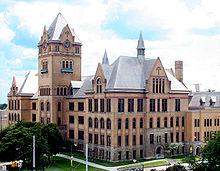
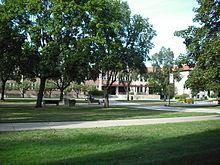
Detroit is home to several institutions of higher learning including Wayne State University, a national research university with medical and law schools in the Midtown area offering hundreds of academic degrees and programs. The University of Detroit Mercy, located in Northwest Detroit in the University District, is a prominent Roman Catholic co-educational university affiliated with the Society of Jesus (the Jesuits) and the Sisters of Mercy. The University of Detroit Mercy offers more than a hundred academic degrees and programs of study including business, dentistry, law, engineering, architecture, nursing and allied health professions. The University of Detroit Mercy School of Law is located Downtown across from the Renaissance Center. Other institutions in the city include the College for Creative Studies, Lewis College of Business, Marygrove College and Wayne County Community College. In June 2009, the Michigan State University College of Osteopathic Medicine which is based in East Lansing opened a satellite campus located at the Detroit Medical Center. The University of Michigan was established in 1817 in Detroit and later moved to Ann Arbor in 1837. In 1959, University of Michigan aeDearborn was established in neighboring Dearborn.
With about 66,000 public school students (2011 ae12), the Detroit Public Schools (DPS) district is the largest school district in Michigan. Detroit has an additional 56,000 charter school students for a combined enrollment of about 122,000 students.[160][161]
In the mid-to-late 1990s, the Michigan Legislature removed the locally elected board of education amid allegations of mismanagement and replaced it with a reform board appointed by the mayor and governor. The elected board of education was re-established following a city referendum in 2005. The first election of the new 11-member board of education occurred on November 8, 2005.[162] Due to growing Detroit Charter Schools enrollment, the city planned to close many public schools.[160] State officials report a 68% graduation rate for Detroit's public schools adjusted for those who change schools.[163][164] Public and charter school students in the city have had mixed results on standardized tests.[165][166]
Detroit is served by various private schools, as well as parochial Roman Catholic schools operated by the Archdiocese of Detroit. The Archdiocese of Detroit lists a number of primary and secondary schools in the city, along with those in the metro area as Catholic education has emigrated to the suburbs.[167][168] There are 23 Catholic high schools in the Archdiocese of Detroit.[169] Of the three Catholic high schools in the city, two are operated by the Society of Jesus and the third is co-sponsored by the Sisters, Servants of the Immaculate Heart of Mary and the Congregation of St. Basil.[169][170]
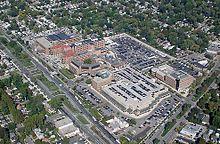
Within the city of Detroit, there are over a dozen major hospitals which include the Detroit Medical Center (DMC), Henry Ford Health System, St. John Health System, and the John D. Dingell VA Medical Center. The DMC, a regional Level I trauma center, consists of Detroit Receiving Hospital and University Health Center, Children's Hospital of Michigan, Harper University Hospital, Hutzel Women's Hospital, Kresge Eye Institute, Rehabilitation Institute of Michigan, Sinai-Grace Hospital, and the Karmanos Cancer Institute. The DMC has more than 2,000 licensed beds and 3,000 affiliated physicians. It is the largest private employer in the City of Detroit.[171] The center is staffed by physicians from the Wayne State University School of Medicine, the largest single-campus medical school in the United States, and the United States' fourth largest medical school overall.[171] Detroit Medical Center formally became a part of Vanguard Health Systems on December 30, 2010 as a for profit corporation. Vanguard has agreed to invest nearly $1.5 B in the Detroit Medical Center complex which will include $417 M to retire debts, at least $350 M in capital expenditures and an additional $500 M for new capital investment.[172] Vanguard has agreed to assume all debts and pension obligations. In 2010, Henry Ford Health System in the New Center also announced a $500 M expansion in Detroit with plans for a biomedical research center. The metro area has many other hospitals including William Beaumont Hospital, St. Joseph's, and University of Michigan Medical Center.
With its proximity to Canada and its facilities, ports, major highways, rail connections and international airports, Detroit is an important transportation hub. The city has three international border crossings, the Ambassador Bridge, Detroit-Windsor Tunnel and Michigan Central Railway Tunnel, linking Detroit to Windsor, Ontario. The Ambassador Bridge is the single busiest border crossing in North America, carrying 27% of the total trade between the U.S. and Canada.[173]
Detroit Metropolitan Wayne County Airport (DTW), the area's principal airport, is located in nearby Romulus and is a primary hub for Delta Air Lines and a secondary hub for Spirit Airlines. Bishop International Airport (FNT) in Flint, Michigan is the second busiest commercial airport in the region. Coleman A. Young International Airport (DET), previously called Detroit City Airport, is on Detroit's northeast side. Although Southwest Airlines once flew from the airport, the airport now maintains only charter service and general aviation.[174] Willow Run Airport, in far-western Wayne County near Ypsilanti, is a general aviation and cargo airport.

Mass transit in the region is provided by bus services. The Detroit Department of Transportation (DDOT) provides service to the outer edges of the city. From there, the Suburban Mobility Authority for Regional Transportation (SMART) provides service to the suburbs. Cross border service between the downtown areas of Windsor and Detroit is provided by Transit Windsor via the Tunnel Bus.[175] It is also possible for those who cross to Detroit on the tunnel bus to use a Transit Windsor transfer for transfers onto Detroit Smart buses, allowing for travel around Metro Detroit from a single fare.
An elevated rail system known as the People Mover, completed in 1987, provides daily service around a 2.9 miles (4.7 km) loop downtown. A proposed bus rapid transit may serve as a link between the Detroit People Mover and SEMCOG Commuter Rail which extends from Detroit's New Center area to The Henry Ford, Dearborn, Detroit Metropolitan Airport, Ypsilanti, and Ann Arbor.[176][177][178] Amtrak provides service to Detroit, operating its Wolverine service between Chicago and Pontiac. Baggage cannot be checked at this location; however, up to two suitcases in addition to any "personal items" such as briefcases, purses, laptop bags, and infant equipment are allowed on board as carry-ons. The Amtrak station is located in the New Center area north of downtown. The J.W. Westcott II, which delivers mail to lake freighters on the Detroit River, is the world's only floating post office.[179]
Metro Detroit has an extensive toll-free network of freeways administered by the Michigan Department of Transportation. Four major Interstate Highways surround the city. Detroit is connected via Interstate 75 (I-75) and I-96 to Kings Highway 401 and to major Southern Ontario cities such as London, Ontario and the Greater Toronto Area. I-75 (Chrysler and Fisher freeways) is the region's main north aesouth route, serving Flint, Pontiac, Troy, and Detroit, before continuing south (as the Detroit aeToledo and Seaway Freeways) to serve many of the communities along the shore of Lake Erie.[180]
I-94 (Edsel Ford Freeway) runs east aewest through Detroit and serves Ann Arbor to the west (where it continues to Chicago) and Port Huron to the northeast. The stretch of the current I-94 freeway from Ypsilanti to Detroit was one of America's earlier limited-access highways. Henry Ford built it to link the factories at Willow Run and Dearborn during World War II. A portion was known as the Willow Run Expressway. I-96 runs northwest aesoutheast through Livingston, Oakland and Wayne counties and (as the Jeffries Freeway through Wayne County) has its eastern terminus in downtown Detroit.[180]
I-275 runs north aesouth from I-75 in the south to the junction of I-96 and I-696 in the north, providing a bypass through the western suburbs of Detroit. I-375 is a short spur route in downtown Detroit, an extension of the Chrysler Freeway. I-696 (Reuther Freeway) runs east aewest from the junction of I-96 and I-275, providing a route through the northern suburbs of Detroit. Taken together, I-275 and I-696 form a semicircle around Detroit. Michigan state highways designated with the letter M serve to connect major freeways.[180]
Detroit has seven sister cities, as designated by Sister Cities International: [181]

Word Count: 10219






